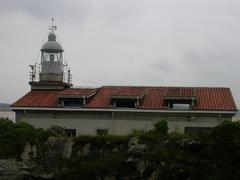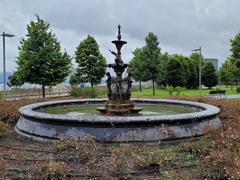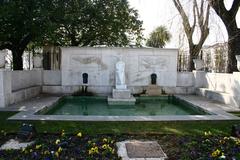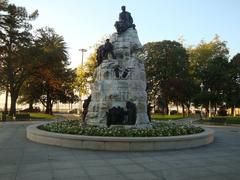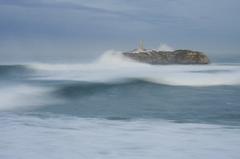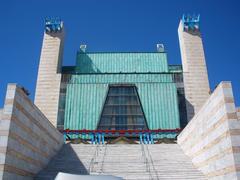Cementerio de Ciriego Visiting Hours, Tickets, and Travel Guide | Santander Historical Sites
Date: 03/07/2025
Introduction
Perched atop a scenic hill in the San Román de la Llanilla district, overlooking the Cantabrian Sea, Cementerio de Ciriego is Santander’s principal cemetery and a site of profound historical, architectural, and cultural significance. Established in the late 19th century, Ciriego serves not only as a resting place for generations of Santanderinos but also as an open-air museum, reflecting over a century of artistic trends, societal shifts, and collective memory.
A member of the European Cemeteries Route, Ciriego is recognized for its exceptional funerary art, including elaborate pantheons, mausoleums, and monuments by prominent Cantabrian architects and sculptors. The cemetery’s cruciform layout, lush landscaping, and seamless integration with the coastal environment offer visitors a contemplative space where history and natural beauty harmoniously converge.
Modern visitor amenities, such as multilingual maps, a mobile app with interactive tours, and accessible pathways, ensure a rewarding experience for all. Whether you are a history enthusiast, art lover, or simply seeking tranquility, this guide will provide everything you need for your visit to Cementerio de Ciriego, from historical context and architectural highlights to practical information and travel tips (Wikipedia; Santander Tourism; Cementerio de Ciriego Official).
Contents
- Overview
- Historical Development
- Architectural Design and Artistic Features
- Visiting Information
- Conservation, Community, and Local Heritage
- Notable Monuments and Art Highlights
- FAQs
- Nearby Attractions
- Visitor Recommendations
- Sources
Historical Development
The need for a new cemetery in Santander arose in the early 19th century as the city expanded and older burial grounds became insufficient. In 1881, municipal architect Casimiro Pérez de la Riva initiated the plans for Cementerio de Ciriego, aiming to reflect both dignity and functionality. After several delays and changes in leadership, the cemetery was inaugurated in 1893 under Joaquín Ruiz Sierra (Wikipedia).
Ciriego’s location—spanning 180,000 square meters and offering panoramic sea views—was carefully chosen to provide a peaceful, contemplative environment removed from the city’s bustle. Over time, it evolved into a repository of Santander’s collective memory, commemorating pivotal events such as the 1868 Revolution and the tragic Cabo Machichaco explosion. Its status as a heritage site is reinforced by its inclusion in the European Cemeteries Route, celebrating its cultural and artistic legacy (Santander Tourism).
Architectural Design and Artistic Features
Master Plan and Layout
Ciriego’s architectural design reflects late 19th-century funerary planning, with a cruciform central section intersected by avenues and alleys dividing the cemetery into “manzanas” (blocks). The orderly layout, surrounded by mature trees and landscaped gardens, creates a serene and navigable space (Santander Tourism).
Notable Pantheons and Monuments
The cemetery is home to a remarkable collection of funerary art, crafted by leading architects and sculptors such as Valentín Ramón Casalís, Emilio de la Torriente, Manuel Casuso Hoyo, Alfredo de la Escalera, and Javier González de Riancho. Standout examples include:
- Panteón de la Familia J. Uzcudun (Pérez de la Riva, 1904): One of the few remaining works by the original architect.
- Panteón de la Familia Pardo (González de Riancho, 1917): A neo-Romanesque Byzantine masterpiece adorned with rare funerary frescoes (mapasde.viajes).
- Monumento a los “Héroes de la libertad”: Commemorates the martyrs of the 1868 Revolution, featuring an angelic sculpture by Villeroy & Boch.
- Monumento conmemorativo Cabo Machichaco: Honors the victims of the 1893 steamship explosion, incorporating maritime motifs (mapasde.viajes).
Artistic and Material Diversity
Ciriego’s monuments showcase a spectrum of styles, from neoclassical and neo-Gothic to modernist and eclectic, employing marble, granite, and bronze. Many feature intricate reliefs, allegorical figures, and personalized inscriptions, illuminating the beliefs and aspirations of generations (Santander Tourism).
Integration with the Landscape
Set atop a hill, the cemetery’s design maximizes sea views and harmony with the natural landscape. The use of local stone and careful monument placement enhances both the aesthetic impact and spiritual resonance of the site (Santander Tourism).
Visitor Navigation
Visitors can follow three main thematic routes—monumental, historical, and memory—using multilingual maps or a dedicated mobile app providing interactive, geo-referenced tours via QR codes (mapasde.viajes).
Visiting Information
Location and Access
- Address: Calle San Román, s/n, 39011 Santander, Spain (serviciosfunerarios.org)
- By Car: 10 minutes from city center; parking available.
- Public Transport: Bus lines 8 and 11 serve the area.
- On Foot/Bicycle: Accessible via local walking and cycling paths (descubresantander.es).
Visiting Hours and Admission
- Open: Daily, 9:00 AM – 7:00 PM (extended summer hours)
- Closed: Mondays (in some periods; check latest details)
- Admission: Free for all visitors (serviciosfunerarios.org)
Accessibility
- Main avenues are wheelchair accessible; some older sections may be uneven.
- Assistance for visitors with reduced mobility is available upon request.
Facilities
- Reception Area: Maps, visitor information, and guidance.
- Restrooms: Available near the main entrance.
- Parking: Adjacent lot for cars and buses.
- Security: Staff present during opening hours.
Visitor Etiquette
- Maintain respectful silence; avoid disturbing ceremonies.
- Photography allowed for personal use; avoid photographing mourners.
- No pets except service animals.
- No food or drink in the cemetery.
Conservation, Community, and Local Heritage
Conservation Initiatives
Since 2018, the Ayuntamiento de Santander has overseen comprehensive restoration projects, notably the acclaimed Panteón de la Familia Pardo, which won the “Best Monument” award in the 2025 Cementerios de España contest (larazon.es). Restoration efforts include preserving mosaics, frescoes, and historical structures, alongside cataloguing and digitalization projects (eltomavistasdesantander.com).
Digital Engagement
The cemetery offers digital tools such as trilingual maps, QR-coded information panels, and 3D monument visualizations to enhance educational outreach and visitor engagement (eltomavistasdesantander.com).
Community Involvement
Ciriego is a focal point for community activities, including open days, art events, and educational workshops. Themed routes and public programs encourage deeper connections with local history and heritage (lapajareramagazine.com).
Commemoration and Memory
The cemetery honors significant events and individuals, such as the victims of the Spanish Civil War, with dedicated memorials and ongoing efforts to recover and recognize their stories. Annual festivals and commemorations further integrate Ciriego into the cultural life of Santander.
Notable Monuments and Art Highlights
- Mausoleum of Menéndez Pelayo: Celebrates the legacy of the famed scholar.
- Monument to Cabo Machichaco: Marks the site of one of Spain’s worst maritime disasters.
- Pando Family Pantheon: Features distinctive underground architecture.
- Sculptural Works: By artists like Valentín Ramón Casalís and Emilio de la Torriente, showcasing styles from realism to modernism (Cementerio de Ciriego Official).
FAQs
What are the visiting hours?
Open daily from 9:00 AM to 7:00 PM (check for seasonal adjustments).
Is there an admission fee?
No, entry is free.
Are guided tours available?
Yes, especially on weekends, public holidays, and during special events. Reservations recommended.
Is the cemetery accessible?
Most main paths are wheelchair accessible; assistance is available.
What are the rules for visitors?
Maintain respectful conduct, limit photography to personal use, and follow posted guidelines.
Nearby Attractions
- Virgen del Mar Hermitage: A coastal chapel with scenic views.
- Santander City Center: Historical sites, museums, and dining.
- Maritime Museum: Explore Cantabria’s seafaring heritage.
Visitor Recommendations
- Best Time to Visit: Early mornings or late afternoons for optimal lighting and tranquility.
- Weather: Santander’s climate is variable; bring a light jacket or umbrella.
- Footwear: Wear comfortable shoes for paved and gravel paths.
- Photography: Capture architectural details and sea vistas while respecting the solemn atmosphere.
- Events: Check the official website for cultural programs and special guided tours.
Visuals and Media
Note: Replace example.com URLs with actual image links or embed interactive maps and 3D tours where available.
Sources and Further Reading
- Wikipedia
- Santander Tourism
- Cementerio de Ciriego Official
- Servicios Funerarios
- El Diario Montañes
- La Razón
- La Pajarera Magazine
- Descubre Santander
Plan Your Visit
Cementerio de Ciriego gracefully combines history, art, and community, offering an immersive experience for visitors and locals alike. Free admission, thoughtfully maintained facilities, and comprehensive interpretive resources make it accessible to all. Ongoing conservation projects and community programming ensure that the cemetery remains both a living part of Santander’s identity and a prime destination for cultural tourism.
To maximize your visit, check for guided tours and events, download the official app for interactive exploration, and consider pairing your visit with other Santander landmarks. Experience the stories, artistry, and memories that make Ciriego an indispensable stop on your journey through Cantabria.
